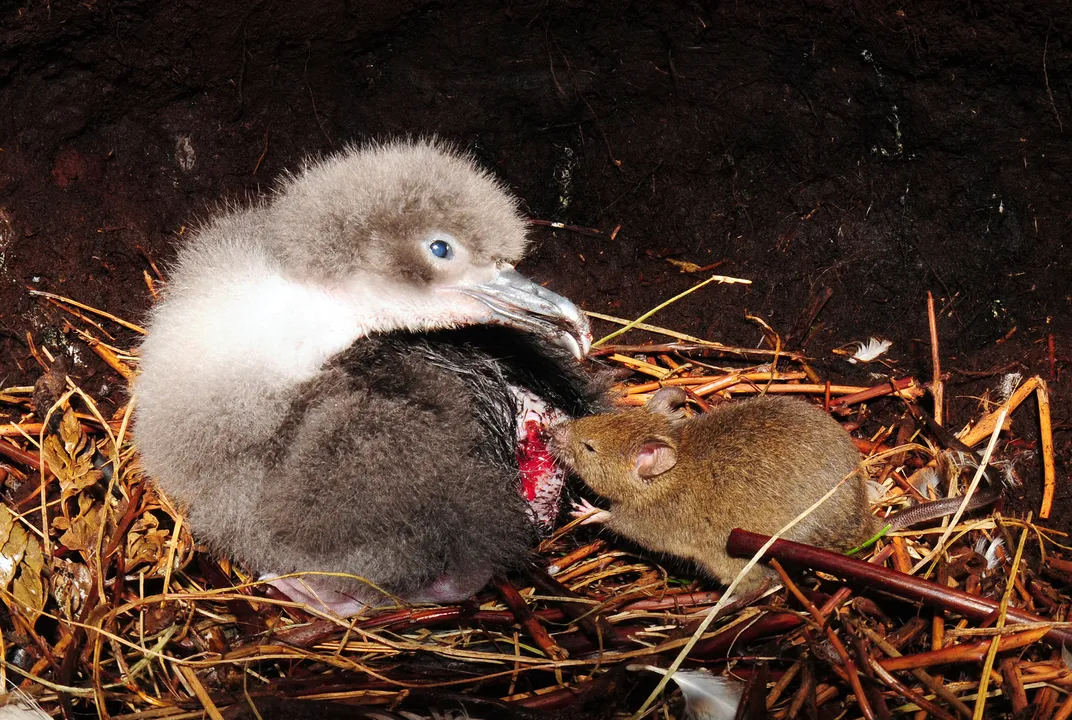A Steady Diet of Seabird Chicks Makes Island Mice Huge
With no predators or competition, rodents can eat baby birds alive
/https://tf-cmsv2-smithsonianmag-media.s3.amazonaws.com/filer/70/7b/707b9274-2b51-4aa2-8e83-75f403916539/creepy_mouse_1.jpg)
Nestled in a remote corner of the South Atlantic, the nearly uninhabited volcanic Gough Island is a nature geek's dream—it hosts some of the world's most important colonies of seabirds and their cute, fluffy babies. But this pristine avian oasis has been invaded by hordes of bizarre predators: giant mice that feed on the flesh of seabird chicks until they die. And the chick deaths are driving some bird species toward extinction—bite by tiny bite.
"It brings tears to my eyes just thinking about it," says Richard Cuthbert, country director for the Wildlife Conservation Society in Papua New Guinea, and a witness to the rodents’ gruesome behavior.
Cuthbert has seen the mice nibble holes in the bodies of young birds and even eat them from the outside in. "It is a death by a thousand nibbles," he says. "It is a pretty horrific way to go."
After studying Gough's mice for years, researchers knew the rodents—the same species, Mus musculus, that is a pest in homes around the world—were unusually large. But now Cuthbert and his colleagues have found that these mice weigh about twice as much as other mice. And their baby seabird diet may be the cause, the team reported recently in the Journal of Mammalogy.
The average mouse on Gough weighs about 1.2 ounces, with some giants reaching a hefty 1.8 ounces. That trumps the body mass of your ordinary house mouse, which weighs a mere 0.7 ounces or so.
"They're the largest and heaviest mice anywhere in the world," Cuthbert says.
And the mice are not just fat, he notes. The rodents’ skeletons are also larger than those of their cousins living elsewhere.
Besides being humongous, the mice are abundant, and quite bold. While Cuthbert and his wife spent some three months camping on the island doing fieldwork in 2000 and 2001, they often found the rodents crawling all over their tents and even trying to burrow their way in.
The mice now found on Gough are probably descendants of rodents that hitched a ride to the island on 19th-century sealing boats. Those first invaders would have been the size of the average house mouse. But in the years since, the Gough population evolved a larger size. Cuthbert and his colleagues wanted to know what drove this evolution, so they captured, measured and weighed animals from different areas of the island, monitoring their condition and survival.
The team found that in areas with high rates of mouse predation on seabird chicks, mice either maintained their body mass or gained weight in winter. This is unusual because mice tend to struggle during this time of the year, when the fruits, seeds and grains they usually eat are scarce. The heavier and larger mice were also more likely to survive during winter, when rates of rodent mortality normally peak.

Cuthbert and his colleagues think that the rare abundance of seabird chick prey during winter, combined with the mice's predatory acumen, has probably favored the evolution of larger bodies.
While the mice on Gough represent an interesting example of a change in body size, similar shifts have also occurred in other island populations of mammals, notes Mark Lomolino, a biogeographer at the State University of New York College of Environmental Science and Forestry who was not involved in the new study. He has observed this phenomenon in the Thousand Islands region, along the Canada-U.S. border in the Saint Lawrence River, among rodents called meadow voles. Though the voles normally weigh around 1.6 ounces, he has caught ones as large as 2.5 or 2.8 ounces on some of the islands.
Smaller animals often get bigger once they are isolated on islands, whereas those that are normally big get smaller, says Lomolino. In many mainland areas, which tend to have a relatively high diversity of species, being either tiny or huge each has its own advantages. Smaller animals, such as mice, might avoid competition while remaining nimble and efficient. But at the other end of the spectrum, being really large might enable an animal, like an elephant, to avoid being food for a predator.
On an island, though, which may not house as many species, some pressures relax. A mouse introduced to an island does not have to compete with any other small mammals because, well, there aren't any. So it can feed on the easily accessible chunks of prey, such as seabird chicks, and finally get to grow.
And on an island devoid of mainland predators, a hypothetical elephant would have no pressures to be really big anymore. Over time, the elephant population might evolve a smaller size. That happened on some Mediterranean islands, says Lomolino, where some ancient elephants evolved a size less than 10 percent of their ancestral body mass.
The callous killing of chicks on Gough is putting a different kind of evolutionary pressure on species on that island. The mice's taste for bird meat poses a deadly threat to two critically endangered bird species—the Tristan albatross and a type of songbird called the Gough bunting. The voracious rodents are also contributing to declines in other avian species on the island. "They are pushing certain species to extinction, and they are threatening the whole island," Cuthbert says.
So far, researchers have been actively studying how to best target the mice in the hopes of getting rid of them. Cuthbert thinks that the only way to do it would require an aerial drop of poison-filled bait pellets. But mounting this type of operation would be a complex, costly and risky undertaking, he says. "There's no hundred-percent chance of success," he says.
"But something we can be a hundred percent sure is that, if we don't do anything, we are going to lose these birds," Cuthbert adds.